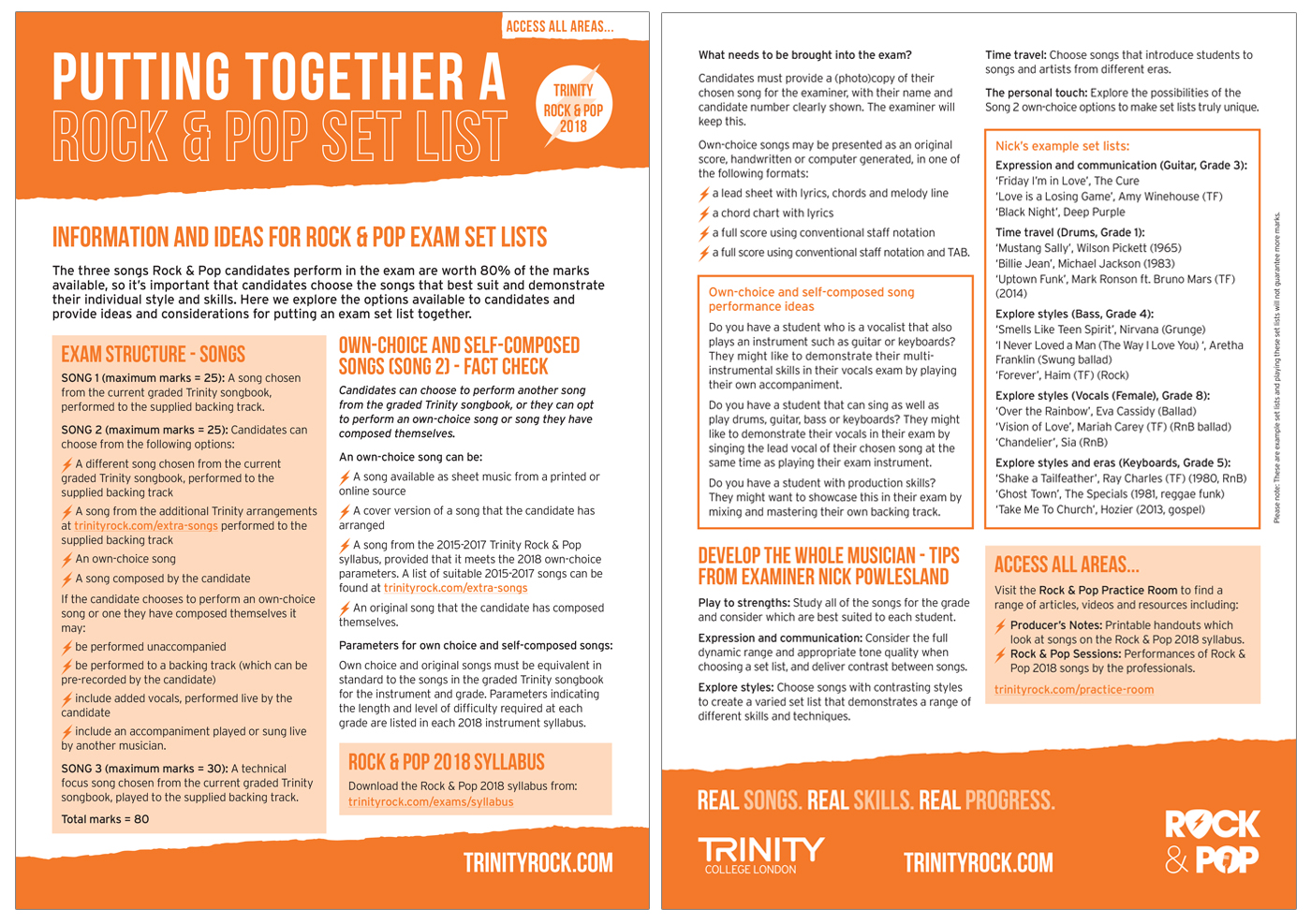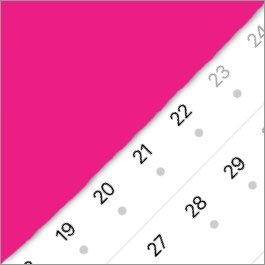WHAT MAKES A GREAT ROCK & POP EXAM SET LIST?
by Nick Powlesland, Senior Examiner for Rock & Pop
As an examiner of Trinity Rock & Pop exams since launch back in 2012, it is fair to say that I have listened to and assessed an incredible amount of renditions of ‘Black Betty’ or ‘Sunshine Of Your Love’! But each version is different because each candidate is different. Every player brings their own set of skills to the process of producing the very best performance they can give and that is always fascinating to me and brings its own freshness to each exam. It is, though, also a real delight when something less commonly-played is included in a set list.
I have selected many pieces for syllabuses and, as well as those tunes you just know will be really popular with teachers and candidates, there are always surprises when it comes to favourite choices. But what influences our decisions as teachers and candidates when choosing a set list for exam purposes? Is it as simple as picking three accessible songs, or the three the candidate likes the most?
DEVELOPING THE WHOLE MUSICIAN
Of course, ease of playing is sure to be a factor, and the thrill of studying favourites is massively inspiring. But should there be a deeper thought process behind the selection? With my teacher hat on for a moment, it would seem that the ideal is to develop the whole musician as well as achieve exam success, while taking into account each and every unique set of candidate needs. It’s not an easy combination to achieve, but I reckon we can maximise the impact of grade preparation if we think this way. So let’s look at some of the set list options that really impress the examiner while simultaneously improving the candidate as a musician.
1. Playing to strengths
To start with the obvious, each song will feature its own range of techniques and expressive challenges. Some will resonate with a candidate because they like the artist or band, or have already played or sung songs with similar skills such as power chords for guitar, slap and pop bass technique or keyboard octaves. ‘Play to your strengths’ is the old saying, and there’s a lot to be said for that, especially when you ultimately want your students to get good marks. But perhaps the best of both worlds would be to study all of the songs and skills for the grade and only then consider those that are best suited for each candidate before deciding on ‘the final three’. That way, nothing is being left out and, at worst, skills are at a developing stage to be picked up later or alongside the exam.
2. Expression and communication
Commonly given less attention is the range of expressive potential featured across all of the Rock & Pop grade songs. Communication is a vital part of all Trinity exams and even the most technically proficient performances still need sensitive musical expression and communication to get the highest marks. The third assessment component in a Rock & Pop exam, Communication and Style, focuses upon mood and character, musical detail and audience engagement. So encourage your students to consider the full dynamic range and the appropriate tone quality – how amazing as an examiner to hear dynamics and tonal colours used effectively to deliver contrast within and between songs. Remember, examiners are musicians and love to hear the contrasts. An example of this would be choosing a gentle, clean-toned ballad like Grade 3 Guitar ‘Love Is A Losing Game’ by Amy Winehouse, nestled between the dynamically broad, chiming pop song 'Friday I'm In Love' by The Cure, and the solid distorted riffing of Deep Purple's 'Black Night'. Don’t forget to ‘perform’ and, done well, watch the communication marks go through the roof!
3. Explore a range of styles
One of the many great attributes of the Rock & Pop syllabuses is that the songs cover a wide range of styles. As examiners it is fantastic to hear the contrast of a balanced choice of songs. A great set list for a Grade 4 bass player could start with 'Smells Like Teen Spirit' by Nirvana, then go for a stylistic gear-shift into 'I Never Loved A Man (The Way I Love You)' by Aretha Franklin before finishing with the breezy pop song 'Forever' by Haim as a Technical Focus choice. A Grade 8 vocalist could really impress with their versatility if they started light with 'Over the Rainbow' by Eva Cassidy, then demonstrated range and controlled melisma in the RnB classic 'Vision Of Love' by Mariah Carey, before showing off belt skills with 'Chandelier' by Sia.
4. Time travel
Style often goes hand-in-hand with the era each song comes from. It may be that your student says that they have no interest in ‘old’ music, but I have often found that students just need a little encouragement to expand their horizons and ultimately appreciate the musical ‘nudge’ into years gone by. It is great to hear a set list cross the decades, such as Wilson Pickett’s ‘Mustang Sally’, Michael Jackson’s ‘Billie Jean’, and Mark Ronson, ft. Bruno Mars’ ‘Uptown Funk’ from Grade 1 Drums, or a great combination of genre and era in Grade 5 Keyboards where you could start with Ray Charles’ ‘Shake a Tailfeather’ before moving on to The Specials’ ‘Ghost Town’ and then finishing right up-to-date with ‘Take me to Church’ by Hozier.
5. The personal touch
The breadth and range of songs contained within the Rock & Pop songbooks is incredible and so there is, arguably, no need to look further for more options. However, an own-choice song 2 offers further potential to shape the set list and make it truly unique. Providing the own-choice parameters are carefully adhered to, this is a brilliant way to fully engage your students by involving them in the creation of their exam content. It also means that if two song choices are already known, you and your student can fully exploit the possibility of selecting a totally contrasting song 2 to show another performance angle, whether that be a different technique, style or mood. And don’t forget to encourage songwriting skills in an Own Composition, another way of making a candidate’s set list stand out from the crowd.
As an examiner it’s always great to hear variety across performers’ set lists, and to hear some of the less well-known songs played. Sure, there are valid reasons why some songs just work, but the flexibility of the set list is there for you to shape in myriad different ways. Hopefully, these musings provide food for thought.
Please note: the set lists in this article are examples; candidates playing these song combinations will be marked in exactly the same way as candidates who choose other combinations.
Get lots of information about putting together a Rock & Pop set list in this Access All Areas PDF.


Nick was born in Plymouth and lived there for 18 years before seeking fame and fortune in London, where he studied at The Guildhall School of Music and Drama. After graduation and a substantial rethink on fame and fortune, he embarked on a musical career of performing, teaching, composing and examining. He is Guitar Consultant for Trinity, has composed pieces and exercises for the Classical, Plectrum Guitar and Rock & Pop syllabuses, and is a Senior Examiner for Rock & Pop.
Following a move to Lancashire in 2000, Nick currently works for the Lancashire Music Service, where he is a Team Leader for the Preston area. His teaching finds him working with individuals or up to 30 children at a time, whilst weekly gigs with his covers band, ‘The Lazy Mondays,’ provide the chance to perform. A lifelong love of Musical Theatre also finds him frequently playing guitar or bass in theatres across the North West.







